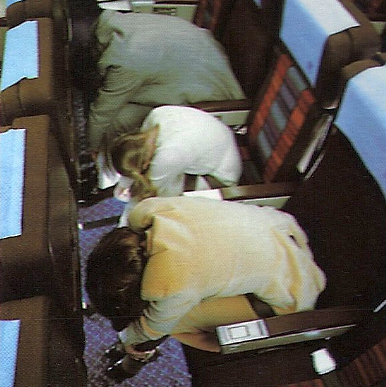The year was 1993 and I was an intern with United Airlines in Flight Dispatch at their corporate headquarters in suburban Chicago. Weekly, I’d fly out to Denver (Stapleton) for scheduled intern meetings among other activities, and I was fortunate to participate in an evacuation exercise at the flight attendant training center.
I posted this in 2011, but with the Asiana Airlines crash in San Francisco this past Saturday, I thought it’d be a good repeat. Would you survive a drill?
I boarded the full-sized sectional mock-up of a Boeing 767 with the rest of my group of interns and sat down with a smirk on my face. “Ha,†I thought. “I’ve flown a couple hundred thousand miles by now, this should be a piece of cake.†I was so cockily certain I’d get myself out in 90 seconds.
The flight attendants running the evacuation drill on the fully automated hydraulic simulator stated that beyond making their “Release seat belts! Get out, leave everything behind!†commands after crashing, they would not assist in the process to evacuate.
We were airborne and the simulator had all the sounds and movement sensations of your typical 767. An emergency was declared and we were told to get into brace positions. Upon crashing (a slightly moderate jolt), the lights went out, smoke filled the cabin and it was pitch black. We were slightly askew in angle and the flight attendants shouted their command to release seat belts.
I honestly don’t recall if the floor lights were on, but I do remember waving my hand in front of my face not being able to see a thing. The smoke smelled real and I began making my way to door 1L, the closest to where I was seated. I’d be lying if I said my heart wasn’t racing just a little.
I absolutely couldn’t believe the disorientation I was experiencing and struggled to gain my footing enough to feel my way up the aisle while bumping into everyone. After a few rows I thought I had reached the door, but instead found another row of seats. It seemed like an eternity, but I was the first to find the door and called back for everyone to come forward.
Did I remember to check outside the window for fire or impassable debris before opening the door? Of course not. I was feeling for the handle and absolutely could not find it. My hands were frantically sweeping over all parts of the door while several more of my fellow interns started doing the same.
The lights came up to reveal a heavily smoke filled cabin with all of the flight attendants exclaiming, “Times up! You’re all dead. And had you opened that door you would have escaped into a burning fire.†I was so pissed.
That was my eye opening experience and I think most airlines leave off their safety videos the two most important things that I learned that day:
- The common statement heard on videos today, “To open the exit, move the handle in the direction of the arrow,†is all fine and good with proper lighting, but if visibility is as poor as what I experienced, you need to know where the handle even is. So, when boarding I look for the handle position on the entry door or door immediately opposite. Some are built into the door and operate like a lever
, some swing widely from left to right, some are on the wall to the right, etc. Now doing this post 9/11 can raise some eyes (“Why are you checking out the door handle?!â€), so I tend to be discreet about it. The same goes with the handle location at the overwing exits.
- Count the number of rows between you and the nearest exit. When it was pitch black, had I known how many rows there were between the door and me, I might have made it sooner through feel knowing I had X-more rows to pass. I think Air New Zealand has this in their safety videos, but definitely not United or American. The “locate the exit nearest your seat†statement on the videos only goes so far in that regard.
Do I remember to do this every time I fly? No, honestly I don’t and I again have gotten complacent with my “expertise” in flying. Hopefully, if I were involved in an actual incident, the flight attendants wouldn’t be incapacitated as they were in my drill experience. I bet they got a chuckle out of all of us that day.
So I’m curious, do you blow off the safety videos, play along and watch, or sometimes consider counting rows, etc?
– Follow Darren Booth on Twitter, @FrequentlyFlyin, for more airline, hotel and travel industry news, reviews and opinions.
Related:
My Emergency Evacuation Off a United Airlines 767 in 1993
Video of Asiana 214 Crash at San Francisco International Airport
Media Coverage of Asiana Airlines Boeing 777 Accident in San Francisco



I always wonder how we are supposed to remember whether the overwing or the rear exits should be opened in case of a water landing. I wish I knew the reasoning behind it, because after a multi-leg journey, it’s hard to remember what to do in each type of aircraft.
I’ve started caring more recently, especially when in an Exit Seat, want to know how to open the door – but also feel a bit weird about staring since these days that might me look like a ‘threat’.
Hadn’t thought of row counting, that’s a good idea.
I was an inflight manager with NWA and later with UAL and had to go through the entire training and Im not a small guy. Not a big guy either. But I played NCAA division I baseball and even for me, i had a hard time throwing the door across the wing on some planes. my GF is a CP with ANA and she is only 5’5 100 pounds and even she is required to chuck this 35+ pound door. Good for the OZ crew. goes to show flight attendants can be NICE, pleasant and kick ass when needed. cept for some domestic airlines where its almost a pre requisite to be a AARP member…shudder….
I’m a first officer, and I do a few sectors here and there as a passenger. It always amazes me at the amount of people who continue talking to each other during the safety briefing, or read the paper, stare out the window, pay no attention. Considering that, it’s miraculous that anyone gets out of a plane after an accident!
@DidItClear: That’s why the flight attendants are there. Hopefully they make the correct decision and direct you to the nearest USABLE exit.
@Matt: Counting rows is invaluable. I hate that US airlines simply state, “the nearest exit may be behind you,” as that’s no good unless you EXACTLY know how far away it is in the event of total darkness (smoke).
@Sambo: Yes, these OZ (Asiana) flight attendants were stellar in this accident. They probably were thinking about their layover in SF when it hit, but they went into immediate action and their training paid off. Amazing how many survived this crash.
@Daniel: Agreed. I’ll certainly be paying more attention on my next flight. Not necessarily to the demo (which needs improvement), but to my surroundings and exit plan.
As a courtesy to others that haven’t heard the safety briefing a bazillion times like I have, I am quiet during the briefing so that others can hear.
Thanks for sharing your personal experience — I didn’t realize the smoke could be that bad. I think that counting rows will be a new part of my onboarding ritual.
So how do we get the airlines to improve the quality / usefulness of their briefings?
And… Try doing all of that while toting your over-weight carry-on bag with you! In still and video pix of Saturday’s event, I was SHOCKED to see the number of IDIOTS hauling their complete ‘kit’ along with them. When that FA screams, “Get Out,” s/he did not include – “and please don’t leave anything behind.’ If you’re no t already wearing it, leave it and GO.
Two other key things…
A) always leave your shoes on for takeoff and landing. Would you wanted to have been barefoot in the debris field at SFO? SK says to leave them on in their safety briefing. I’m not aware of any other carrier that does. It really is a good idea.
B) Have your passport and wallet in your pocket (not overhead locker, etc) for takeoff and landing. While provisions would invariably be made for these walletless, it is ideal to be able to easily clear immigration and not have to worry about forms of payment (assuming you survive).
Small world. I interned in the United Flight Ops office in LA in 1994 and traveled several times to Denver. I don’t remember doing an evac but a couple of us did crash one of the 727 sims late one night. 🙂